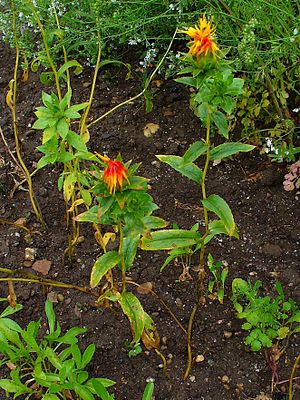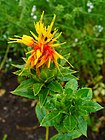Note: This is a project under development. The articles on this wiki are just being initiated and broadly incomplete. You can Help creating new pages.
Difference between revisions of "Carthamus tinctorius"
| (3 intermediate revisions by the same user not shown) | |||
| Line 1: | Line 1: | ||
| − | + | [[File:Carthamus tinctorius 001.JPG|thumb|right]] | |
| + | '''Carthamus tinctorius''' is an erect, thistle-like, often spined annual plant. It can grow up to 180cm tall. The plant has a deep taproot and a strong stem with many branches, each terminating in a flower. | ||
==Uses== | ==Uses== | ||
| − | {{Uses|}}, {{Uses|}}, {{Uses|}}, {{Uses| | + | {{Uses|Lower cholesterol}}, {{Uses|Tumours}}, {{Uses|Stomatitis}}, {{Uses|Coronary diseases}}. |
==Parts Used== | ==Parts Used== | ||
| − | {{Parts Used| | + | {{Parts Used|Young leaves}}, {{Parts Used|Seeds}}. |
==Chemical Composition== | ==Chemical Composition== | ||
| Line 11: | Line 12: | ||
==Common names== | ==Common names== | ||
| − | {{Common names|sa=|en=|gu=|hi=|kn=|ks=|ml=|mr=|pa=|ta=|te=}} | + | {{Common names|sa=|en=Safflower|gu=|hi=Kusum|kn=|ks=|ml=|mr=|pa=|ta=Kusumba|te=}} |
==Properties== | ==Properties== | ||
| Line 17: | Line 18: | ||
===Dravya=== | ===Dravya=== | ||
===Rasa=== | ===Rasa=== | ||
| − | |||
===Guna=== | ===Guna=== | ||
| Line 30: | Line 30: | ||
==Habit== | ==Habit== | ||
| − | {{Habit|}} | + | {{Habit|Annual}} |
==Identification== | ==Identification== | ||
| Line 49: | Line 49: | ||
==Mode of Propagation== | ==Mode of Propagation== | ||
| − | {{Propagation|}} | + | {{Propagation|Seeds}} |
==How to plant/cultivate== | ==How to plant/cultivate== | ||
| − | <ref name="How to plant/cultivate"/> | + | Safflower probably grows best in the semi-arid subtropics, but cultivars have been developed that widen its range and it is now cultivated from the temperate zone to higher elevations in the tropics.<ref name="How to plant/cultivate"/> |
==Commonly seen growing in areas== | ==Commonly seen growing in areas== | ||
| − | {{Commonly seen| | + | {{Commonly seen|Poor dry soils in full sun}}. |
==Photo Gallery== | ==Photo Gallery== | ||
<gallery class="left" caption="" widths="140px" heights="140px"> | <gallery class="left" caption="" widths="140px" heights="140px"> | ||
| + | Azafran 02.jpg | ||
| + | Carthamus tinctorius 001.JPG | ||
| + | Carthamus tinctorius 002.JPG | ||
| + | Carthamus tinctorius 050709a.JPG | ||
</gallery> | </gallery> | ||
| Line 69: | Line 73: | ||
<ref name="Leaf">["morphology"]</ref> | <ref name="Leaf">["morphology"]</ref> | ||
| − | <ref name="How to plant/cultivate">[ | + | <ref name="How to plant/cultivate">[http://tropical.theferns.info/viewtropical.php?id=Carthamus+tinctorius Cultivation]</ref> |
</references> | </references> | ||
==External Links== | ==External Links== | ||
| − | * [ ] | + | * [http://www.flowersofindia.net/catalog/slides/Safflower.html Carthamus tinctorius on flowersofindia.net] |
| − | * [ | + | * [https://hort.purdue.edu/newcrop/duke_energy/Carthamus_tinctorius.html Carthamus tinctorius on hort.purdue.edu] |
| − | |||
[[Category:Herbs]] | [[Category:Herbs]] | ||
[[Category:Pages without herbs images]] | [[Category:Pages without herbs images]] | ||
Latest revision as of 19:43, 15 September 2020
Carthamus tinctorius is an erect, thistle-like, often spined annual plant. It can grow up to 180cm tall. The plant has a deep taproot and a strong stem with many branches, each terminating in a flower.
Contents
- 1 Uses
- 2 Parts Used
- 3 Chemical Composition
- 4 Common names
- 5 Properties
- 6 Habit
- 7 Identification
- 8 List of Ayurvedic medicine in which the herb is used
- 9 Where to get the saplings
- 10 Mode of Propagation
- 11 How to plant/cultivate
- 12 Commonly seen growing in areas
- 13 Photo Gallery
- 14 References
- 15 External Links
Uses
Lower cholesterol, Tumours, Stomatitis, Coronary diseases.
Parts Used
Chemical Composition
Common names
| Language | Common name |
|---|---|
| Kannada | |
| Hindi | Kusum |
| Malayalam | |
| Tamil | Kusumba |
| Telugu | |
| Marathi | |
| Gujarathi | |
| Punjabi | |
| Kashmiri | |
| Sanskrit | |
| English | Safflower |
Properties
Reference: Dravya - Substance, Rasa - Taste, Guna - Qualities, Veerya - Potency, Vipaka - Post-digesion effect, Karma - Pharmacological activity, Prabhava - Therepeutics.
Dravya
Rasa
Guna
Veerya
Vipaka
Karma
Prabhava
Habit
Identification
Leaf
| Kind | Shape | Feature |
|---|---|---|
Flower
| Type | Size | Color and composition | Stamen | More information |
|---|---|---|---|---|
| {{{5}}} |
Fruit
| Type | Size | Mass | Appearance | Seeds | More information |
|---|---|---|---|---|---|
Other features
List of Ayurvedic medicine in which the herb is used
Where to get the saplings
Mode of Propagation
How to plant/cultivate
Safflower probably grows best in the semi-arid subtropics, but cultivars have been developed that widen its range and it is now cultivated from the temperate zone to higher elevations in the tropics.[3]
Commonly seen growing in areas
Photo Gallery
References
- ↑ ["chemistry"]
- ↑ ["morphology"]
- ↑ Cultivation
External Links
- Ayurvedic Herbs known to be helpful to treat Lower cholesterol
- Ayurvedic Herbs known to be helpful to treat Tumours
- Ayurvedic Herbs known to be helpful to treat Stomatitis
- Ayurvedic Herbs known to be helpful to treat Coronary diseases
- Herbs with Young leaves used in medicine
- Herbs with Seeds used in medicine
- Herbs with common name in Hindi
- Herbs with common name in Tamil
- Herbs with common name in English
- Habit - Annual
- Index of Plants which can be propagated by Seeds
- Herbs that are commonly seen in the region of Poor dry soils in full sun
- Herbs
- Pages without herbs images




